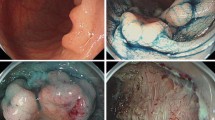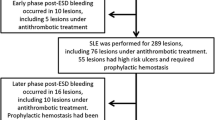Abstract
A 76-year-old man diagnosed with early-stage colorectal cancer was referred to our hospital for endoscopic submucosal dissection (ESD). The patient had a low platelet count (31,000/µL) due to immune thrombocytopenia (ITP). The cancerous lesion was completely resected without any adverse events. A blood test performed 1 day post-ESD showed no progression of anemia and the initial postoperative course was uneventful. However, 7 days after ESD, dark red stools were observed, and we performed an emergency colonoscopy. We stopped the bleeding twice using hemoclips and hemostatic forceps. Since the patient’s platelet count remained below 50,000/µL, we started thrombopoietin receptor agonist treatment with eltrombopag (12.5 mg/day) for thrombocytopenia. Although the platelet count increased, the patient experienced rebleeding for the fourth time and underwent an emergency colonoscopy, during which we used an over-the-scope clip (OTSC) to achieve hemostasis. No rebleeding occurred after OTSC intervention, and the platelet count stabilized at approximately 50,000/µL. We discharged the patient on Day 34 after ESD. Although the guidelines do not specify a target platelet count for performing ESD, a platelet count < 50,000/µL should be considered low. Furthermore, an OTSC may be useful for treating intractable bleeding.




Similar content being viewed by others
References
Neunert C, Lim W, Crowther M, et al. The American Society of Hematology 2011 evidence-based practice guideline for immune thrombocytopenia. Blood. 2011;117:4190–207.
Cines DB, Blanchette VS. Immune thrombocytopenic purpura. N Engl J Med. 2002;346:995–1008.
Rodeghiero F, Stasi R, Gernsheimer T, et al. Standardization of terminology, definitions and outcome criteria in immune thrombocytopenic purpura of adults and children: report from an international working group. Blood. 2009;113:2386–93.
Nakajima T, Saito Y, Tanaka S, et al. Current status of endoscopic resection strategy for large, early colorectal neoplasia in Japan. Surg Endosc. 2013;27:3262–70.
Ghassemi KA, Jensen DM. Evolving techniques for gastrointestinal endoscopic hemostasis treatment. Expert Rev Gastroenterol Hepatol. 2016;10:615–23.
Kobara H, Mori H, Nishiyama N, et al. Over-the-scope clip system: a review of 1517 cases over 9 years. J Gastroenterol Hepatol. 2019;34:22–30.
Hagel AF, Naegel A, Lindner AS, et al. Over-the-scope clip application yields a high rate of closure in gastrointestinal perforations and may reduce emergency surgery. J Gastrointest Surg. 2012;16:2132–8.
Neunert C, Noroozi N, Norman G, et al. Severe bleeding events in adults and children with primary immune thrombocytopenia: a systematic review. J Thromb Haemost. 2015;13:457–64.
Kaufman RM, Djulbegovic B, Gernsheimer T, et al. Platelet transfusion: a clinical practice guideline from the AABB. Ann Intern Med. 2015;162:205–13.
Ciavarella D, Reed RL, Counts RB, et al. Clotting factor levels and the risk of diffuse microvascular bleeding in the massively transfused patient. Br J Haematol. 1987;67:365–8.
Counts RB, Haisch C, Simon TL, et al. Hemostasis in massively transfused trauma patients. Ann Surg. 1979;190:91–9.
British Committee for Standards in Haematology, Blood Transfusion Task Force. Guidelines for the use of platelet transfusions. Br J Haematol. 2003; 122:10–23.
Spahr JE, Rodgers GM. Treatment of immune-mediated thrombocytopenia purpura with concurrent intravenous immunoglobulin and platelet transfusion: a retrospective review of 40 patients. Am J Hematol. 2008;83:122–5.
Oka S, Tanaka S, Kanao H, et al. Current status in the occurrence of post-operative bleeding, perforation and residual/local recurrence during colonoscopic treatment in Japan. Dig Endosc. 2010;22:376–80.
Akimoto T, Goto O, Nishizawa T, et al. Endoscopic closure after intraluminal surgery. Dig Endosc. 2017;29:547–58.
Osada T, Sakamoto N, Ritsuno H, et al. Process of wound healing of large mucosal defect areas that were sutured by using a loop clip—assisted closure technique after endoscopic submucosal dissection of a colorectal tumor. Gastrointest Endosc. 2013;78:793–8.
Nishizawa T, Ochiai Y, Uraoka T, et al. Endoscopic slip-knot clip suturing method: a prospective pilot study (with video). Gastrointest Endosc. 2017;85:433–7.
Nishizawa T, Akimoto T, Uraoka T, et al. Endoscopic string clip suturing method: a prospective pilot study (with video). Gastrointest Endosc. 2018;87:1074–8.
Lee SP, Sung IK, Kim JH, et al. Effect of prophylactic endoscopic closure for an artificial ulceration after colorectal endoscopic submucosal dissection: a randomized controlled trial. Scand J Gastroenterol. 2019;54:1291–9.
Nomura S, Shimura T, Katano T, et al. A multicenter, single-blind randomized controlled trial of endoscopic clipping closure for preventing coagulation syndrome after colorectal endoscopic submucosal dissection. Gastrointest Endosc. 2020;91:859–67.
Brandler J, Baruah A, Zeb M, et al. Efficacy of over-the-scope clips in management of high-risk gastrointestinal bleeding. Clin Gastroenterol Hepatol. 2018;16:690–6.
Acknowledgements
We would like to thank Editage (www.editage.com) for English language edits.
Author information
Authors and Affiliations
Contributions
Manuscript writing: KM and TT; Manuscript editing and revisions: KS, YM, HI, and SR. All authors approved the final version of the manuscript.
Corresponding author
Ethics declarations
Conflict of interest
The authors declare that they have no conflict of interest.
Ethics approval
All procedures followed were in accordance with the ethical standards of the responsible committee on human experimentation (institutional and national) and with the Helsinki Declaration of 1975, as revised in 2008(5).
Informed consent
Informed consent was obtained from the patient for this publication.
Additional information
Publisher's Note
Springer Nature remains neutral with regard to jurisdictional claims in published maps and institutional affiliations.
Rights and permissions
About this article
Cite this article
Miyaguchi, K., Tashima, T., Sugimoto, K. et al. Hazardous repeat bleeding after colorectal endoscopic submucosal dissection in a patient with immune thrombocytopenia: complete hemostasis using an over-the-scope clip. Clin J Gastroenterol 14, 1126–1130 (2021). https://doi.org/10.1007/s12328-021-01401-x
Received:
Accepted:
Published:
Issue Date:
DOI: https://doi.org/10.1007/s12328-021-01401-x




